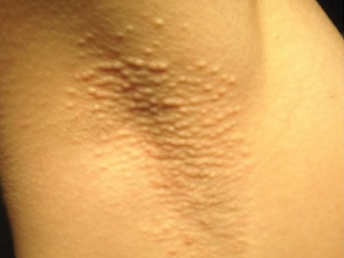Fox-Fordyce disease is a chronic disease of the apocrine glands characterized by the development of pruritic papular eruptions in the axillae, around the nipples, and in the pubic area. ICD-10 Code: L75.2
The disease is typical of young women between the onset of puberty and menopause, but can also occur in children shortly after puberty and during the climacteric period.
Fox-Fordyce disease is characterized by intradermal occlusion of the apocrine ducts. This results in apocrine anhidrosis and intradermal rupture of vesicles that form due to sweat retention.The disease presents as symmetrical eruptions in areas where apocrine sweat glands are located (axillae, umbilicus, pubic region, perineum, etc.) with shiny, hemispherical, sometimes conical papules, round in outline, 2-3 mm in diameter, sometimes larger, and firm to the touch. The papules are densely packed but do not tend to coalesce. They gradually decrease in size toward the periphery of the affected area. The surface of the papules may be hyperkeratotic. The eruptions are slightly reddish or cyanotic, but some individual papules may have the color of normal skin. Intense pruritus is typically observed in the affected areas, and hair may break or fall out. Over time, cysts, lichenification, and impetiginization may occur.
Apocrine anhidrosis is typical, and itching can be triggered by emotional, physical, or pharmacologic stress (e.g., adrenaline 0.1 mg intradermally). The disease is chronic. In some patients, pruritus may worsen before menstruation and decrease during pregnancy. In the postmenopausal period, regression of the process can be expected.- Darier disease
- Acanthosis nigricans
- Lichen planus
- Syringomas
- Pseudo-Fox-Fordyce syndrome
- Lichen simplex chronicus
- Elastic pseudoxanthoma
Treatment of Fox-Fordyce disease is challenging.
Topical glucocorticoids have limited efficacy, with better results observed with intralesional (crystalline suspension of triamcinolone acetonide) or oral administration (at high doses, with recurrence after discontinuation). Local antibiotics and antiseptic solutions can help prevent superinfection. Good results are seen with topical application of tretinoin cream, which provides good relief of pruritus and normalizes hair growth, but its effect on papules is minimal. In women with Fox-Fordyce disease, the use of oral contraceptives, especially a combination of estrogen and progestin, may give good results. Recurrence can be expected after discontinuation. In refractory cases, plastic surgical excision with skin grafting is recommended.
